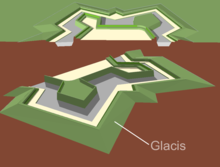Glacis (fortress construction)
The glacis [ɡlaˈsiː] ( French originally for slope ) is in modern fortress construction a gently rising earth fill in front of the ditch from the field side. It served the defenders on the ramparts as a field of fire and, by avoiding blind spots, offers attackers as little cover as possible.
In contrast to temporary fortified camps, they also served as parapets in a permanent fortress , which protected a covered path from the effects of fire and made it possible to defend the trench.
Ideally, the glacis was undeveloped and not overgrown with trees in order to deny opposing troops any opportunity to take cover. In addition, deep-rooted plants were often planted on a glacis to make it more difficult to dig approach ditches. Also barricades could be created as an approach obstacle on the Glacis. In connection with the pentagonal shape of the bastions and the regular, polygonal ground plan of the fortress walls, the creation of a glacis prevented a space from being created that was deprived of the fortress' guns. In the course of time, the glacis was piled higher and higher in order to make it more difficult for enemy troops to approach the fortifications.
Place names that point to the former glacis
Today, in many cities, street names containing the word Glacis indicate the former presence of fortifications :
- Aachen Glacis in Cologne
- Allée des Glacis in Saint-Omer
- Alsterglacis , Glacischaussee , Holstenglacis in Hamburg
- At the Glacis in Leoben
- Weseler Glacis with the streets Am Lippeglacis, Am Nordglacis, Am Ostglacis, Am Westglacis in Wesel
- Avenue des Glacis in Saint-Omer
- Chemin de Glacis in Bapaume , Longwy , Saint-Omer , Talant
- Glacis in Gorinchem , Portland (Dorset),
- Glacis in Brno , today Koliště in Czech
- Glacis in Würzburg ( Ringpark )
- Glacis and Glacis Bridge in Ingolstadt
- Glacis Bridge in Minden
- Glacischaussee in Hamburg
- Glacisgasse in Leoben
- Glacis Road in Gibraltar
- Glacisstraat in Bergen op Zoom , Geertruidenberg , Sas van Gent , Vlissingen
- Glacisstrasse in Breisach am Rhein , Dresden , Germersheim , Graz , Landau , Neu-Ulm , Solothurn
- Glacisweg in Berlin , Freiburg , Hellevoetsluis , Hulst , Maastricht , Philippsburg , Mainz-Kastel , Würzburg
- Holstenglacis in Hamburg
- In the Glacis in Saarlouis
- Impasse de Glacis in Agde
- Marienglacis , part of the Minden Glacis in Minden
- Place du Glacis in Luxembourg
- Rue des Glacis in Auxonne , Belfort , Besançon , Douai , Longwy , Liège , Nancy , Quebec , Saint-Quentin , Valenciennes
- Rue des Glacis-de-Rive in Geneva
- Rue du Glacis in Châtillon-sur-Loire , Cheilly-lès-Maranges , Fléron , Les Aix-d'Angillon, Melle (Deux-Sèvres) , Montreal , Rousies, Saint-Augustin (Seine-et-Marne), Saint-Gervais -en-Vallière, Tournan-en-Brie , Venizy
- Vorgebirgsglacisweg in Cologne
In Magdeburg , Minden , Neu-Ulm , Torgau and Würzburg , the city park is also called this, which is located on the former glacis and in the moat.
In Neu-Ulm, the Glacis-Galerie shopping center is also named after it, which was built in the immediate vicinity of the Glacis there.

